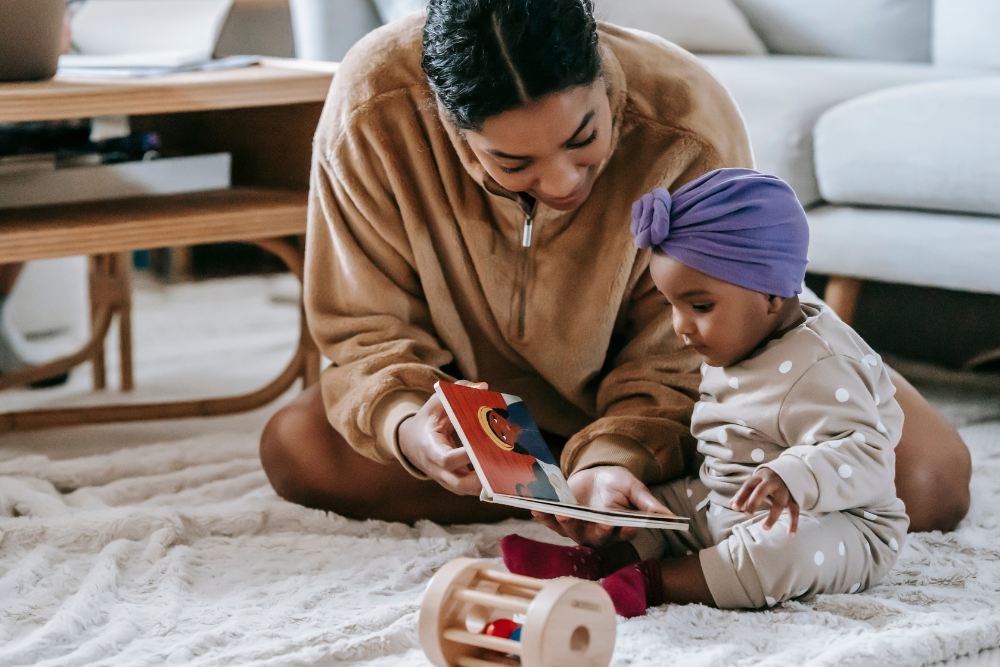From enhancing brain development, to increasing bonding with parents and caregivers, research shows a significant range of benefits from reading aloud with young children.
Despite these benefits, 25% of Australian parents only read to their children once a week or not at all1, and only around half of parents with children aged 0–5 (47%) are aware of the advice that children should be read aloud to from birth.2
Given the importance, how can we help parents to read with their children? And what exactly does the research tell us about the short- and long-term benefits?
Reading helps with early brain development
As leading neuroscientist Professor Sam Wass puts it “Babies’ brains are messy.” There is so much new information to take in that “their brain rhythms are naturally all over the shop”.
Reading aloud to children – with its naturally exaggerated rhythms, predictable story structure, and features such as meter and rhyme – can help to ‘nudge’ a child’s brain into strong, stable rhythmic activity.3 This helps the developing brain to detect patterns and meaning in language.4
The physical form of the book is especially beneficial for this kind of developmental learning with its combination of static images, and ability for children to participate in the experience through turning the page, slowing down the pace or speeding up, and reacting to the narrative elements of the story.
Reading increases bonding with parents and caregivers
Reading a story can be a fun and joyous shared activity for children and caregivers. But the benefits go beyond that.
Research from the UK shows that reading quite literally ‘bonds’ parents and children through synchronising their brainwaves, breathing and heart rate. This experience is deeply comforting for babies, and helps form strong emotional bonds with parents.
And the benefits aren’t just for children. Three in four (74%) Australian parents believe that reading to their child provides them with an important bonding experience,5 and 90% of parents agree that books can create opportunities for conversation with children.
Reading supports language exposure for young children
Reading books is a valuable source of language exposure for young children.
American researchers estimate that if a child is read just one book a day in their first five years of life, they will hear on average an extra 78,000 words more per year than children who are never read to. That’s almost 300,000 more words by the time they start school!
These benefits also extend to ‘receptive language’ – helping children to contextualise their environment, better understand language, and effectively express themselves.
Top tips for reading with children
Start early: With up to 85% of brain development happening during the first three years, it’s important to engage children with reading early on! Reading from infancy is key to passing on the joys and benefits of reading.
Make scheduled time: Life can be busy – especially as a new parent. Make regularly scheduled time in your days and week to read with children from a young age. ‘Bedtime story’ is a classic for a reason!
Let children lead: Allowing children to be a co-pilot of the reading experience can help them better absorb the joys and benefits of reading. That might be slowing down or speeding up, letting them skip pages, or returning to the previous section.
Embrace re-reading: Does your child want the same book over and over? Don’t fight it! Re-reading is a great way to build familiarity with texts, and enhance brain development through rhythm and repetition. Plus, we all know the comfort associated with returning a much-loved story.
Grow your confidence: You don’t have to be an avid reader or professional voice actor to read aloud to your children. Find books you’re comfortable reading and enjoy, and take it page by page. Remember, children will love it because it’s coming from you!
Involve children in book selection: Research shows that children are more likely to read and enjoy a book they’ve chosen themselves. So, when children are old enough, take them along to the library or bookstore to choose their next great book.
Want some help? Explore Australian-based resources:
- Words Grow Minds – resources and information for parents to support children’s development.
- Raising Children – Information and activities for parents to support early literacy in children.
- Better Beginnings and First 5 Forever – support for finding great books to read together, in multiple languages.
- StoryBox Hub – digital literacy resource for children, parents and teachers.
- Storytime at your local library – search your local or state library network to find your local event.
- National Simultaneous Storytime – annual celebration of reading with children, with a range of supporting resources.
- Foundation for Literacy and Learning – provides evidence, support and expertise about literacy learning for teachers, parents and policymakers.
- Gift of Words 2021, Oxford Children’s Language Australia (2021) ↩︎
- Kids and Families Reading Report, Scholastic, Australia (2015) ↩︎
- Goswami, U. Language acquisition and speech rhythm patterns: an auditory neuroscience perspective. (2022) ↩︎
- Choisdealbha, Á. N. et al. Cortical tracking of visual rhythmic speech by 5‐and 8‐month‐old infants: Individual differences in phase angle relate to language outcomes up to 2 years. (2024) ↩︎
- Gift of Words 2021, Oxford Children’s Language Australia (2021) ↩︎

